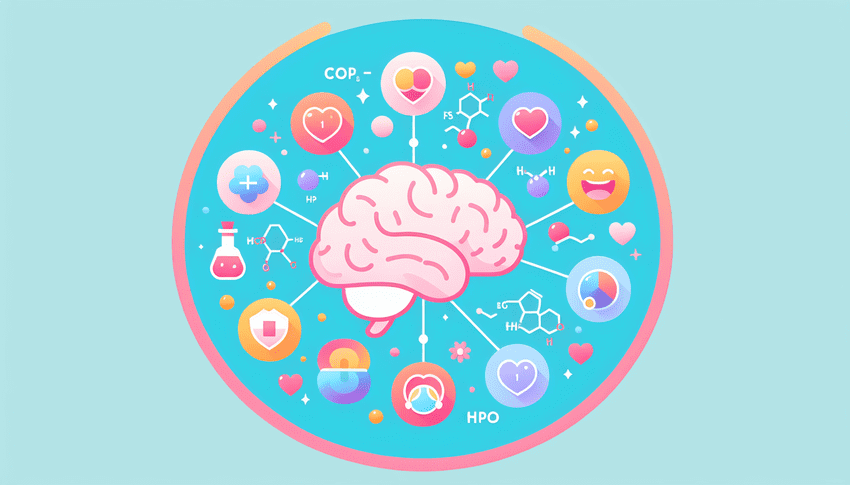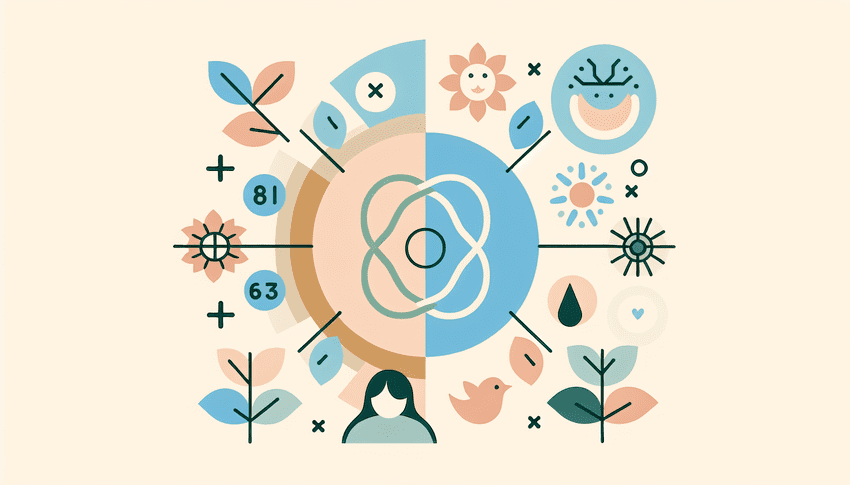Table of Contents
The Power of Gratitude in Cultivating a Positive Mindset

Understanding Gratitude as an Emotional Catalyst
The concept of Gratitude and Positivity does more than simply provide us with a fleeting sense of contentment. At its core, gratitude acts as an emotional catalyst, igniting a chain reaction that can result in a more sustained and resilient form of happiness. Research in psychology and neuroscience has begun to decode the profound impacts that gratitude has on our minds and bodies, suggesting transformative effects that extend beyond mere mood enhancement.
Neurological Pathways to a Positive Outlook
Gratitude’s power lies in its ability to activate specific parts of the brain associated with emotional regulation and the release of feel-good hormones. Studies utilizing functional magnetic resonance imaging (fMRI) have revealed that practicing Gratitude Techniques activates the prefrontal cortex – an area implicated in decision-making and learning. This activation is indicative of the brain’s plasticity in response to experiences that foster a Positive Mindset Development.
- Dopamine and serotonin, neurotransmitters linked to pleasure and satisfaction, are released in increased amounts when individuals engage in exercises of gratitude. This biochemical response not only provides immediate pleasure but also contributes to the conditioning of the brain to seek out positive patterns.
- The hypothalamus, which controls critical bodily functions like appetite and sleep, is also impacted by gratitude, leading to improved physical health and well-being.
- Regular engagement with gratitude can strengthen neural pathways that reinforce positive thinking and gratitude, making it easier over time to frame experiences in a positive light.
The Psychological Reinforcement of a Grateful Mindset
The benefits of a Grateful Mindset are not limited to neurochemical alterations. It extends to the way we interpret daily events. The adoption of gratefulness as a practiced mindset encourages a thematic re-appraisal of life events. For instance, individuals who integrate ‘Positive Thinking and Gratitude’ into their daily routines often report not only that they feel more content but they actually experience more life events as positive.
It is through this re-narration of one’s day-to-day experience that the sustained virtue of gratitude comes to life. Historical philosophical and religious texts have long celebrated the merits of gratitude, and contemporary empirical evidence provides support for its enduring impact on human flourishing.
- Positive affirmations and reflections can aid individuals in identifying and appreciating the previously unnoticed positives in their life, building a cycle of positivity that expands over time.
- Gratitude challenges the ‘negativity bias’ of the brain, a natural inclination to focus on risks and threats, thus reshaping our mindset towards a bias for the positive.
- Gratitude practice has been shown to correlate with increased resilience, helping individuals to bounce back more rapidly from challenging circumstances.
By embracing gratitude, we not only enhance our current emotional state but also lay the groundwork for a more positive, resilient outlook on life. The implementation of gratitude is not merely a nicety; it is a pivotal ingredient in the pursuit of mental wellness and vigor. Through each gesture of thankfulness, we are potentially rewiring our brains to accentuate the positive and diminish the weight of the negative, propelling ourselves along a path that leads to a more satisfied and meaningful existence.
Practical Strategies for Implementing Gratitude in Daily Life
In today’s fast-paced society, cultivating a grateful mindset can prove to be transformative, enhancing our overall quality of life and fostering a positive attitude. Embracing gratitude and positivity is more than a mere feel-good mantra; it is a scientifically-backed approach to mental development and personal growth. When we actively practice gratitude and positivity, we pave the way for sustainable happiness and resilience.
Gratitude techniques need not be time-consuming or complex. Simple, intentional actions can lead to substantial changes in our outlook and well-being. One effective method is maintaining a gratitude journal. By jotting down things we are grateful for each day, we are training our mind to focus on the positive aspects of our lives, even during challenging times.
Strategies to Cultivate a Grateful Mindset
To incorporate gratitude into your daily life, consider these actionable steps:
- Begin your day by reflecting on three things you are sincerely thankful for, no matter how small they may seem. Positive thinking and gratitude are not about grand gestures but recognizing the value in the ordinary.
- Transform routine tasks into moments of reflection. For instance, while having your morning coffee, use this quiet time to think about the efforts that went into making it – from the farmers to your own ability to savor it.
- Make it a habit to express your appreciation to others. Send a thank you message, compliment someone’s effort, or simply smile. These acts of kindness reinforce a positive mindset development and can create a ripple effect of gratitude.
Gratitude isn’t about ignoring life’s difficulties but viewing them through a lens of thankfulness. This shift in perception can transform challenges into opportunities for personal development.
Real-Life Applications of Gratitude Techniques
Consider the impact of positive thinking and gratitude in the workplace. Employees who feel appreciated are more likely to be productive and satisfied with their jobs. Introducing regular team meetings where accomplishments are recognized and gratitude is expressed can fortify team cohesion and a supportive corporate culture.
Meanwhile, in personal relationships, showing gratitude can deepen connections. Something as simple as acknowledging your partner’s daily contributions can enhance mutual respect and affection.
In conclusion, the development of a grateful mindset through simple, daily practices not only nurtures a more joyful existence but also strengthens interpersonal relationships and professional engagements. By integrating gratitude and positivity into every aspect of our lives, we open the door to a more fulfilling and optimistic outlook.
Affirmations and Their Role in Reinforcing Positive Thinking

The Psychological Mechanics Behind Affirmations
Understanding the psychological mechanics behind affirmations requires diving into the terrain of cognitive psychology and the sheer power of belief. By regularly practicing positive thinking and gratitude, individuals can embark on an internal journey of transformation that reshapes their mental landscapes, influencing perceptions, attitudes, and behaviors in profound ways.
Affirmations are, at their core, statements aimed at harnessing the elasticity of brain plasticity. They are designed with the purpose of encouraging a grateful mindset while solidifying a scaffold upon which a positive mindset development can be built. The effectiveness of these affirmations lies deeply entrenched in the concept of self-suggestion, a critical cognitive process whereby the repetition of positive and empowering phrases or statements can persuade the mind towards a more grateful and affirmative state.
Internalization of Positive Self-Suggestions
The process of internalizing positive affirmations is akin to training a muscle – consistent practice and repetition contribute to strength and endurance. Gratitude and positivity, when integrated into regular lexicons, begin to alter neural pathways through a phenomenon known as cognitive restructuring. This essentially means that with each positive affirmation, the brain subtly shifts away from negative thinking patterns and moves towards fostering a Grateful Mindset.
Research in the field of neuroscience indicates that gratitude techniques, like affirmations, activate regions of the brain associated with emotional processing and reward. This organic release of ‘feel-good’ neurotransmitters crafts a Positive Thinking and Gratitude feedback loop – as the brain lights up with positivity, the body responds in tune, bearing a plethora of wellness benefits from reduced stress to enhanced emotional equilibrium.
Real-World Applications & Benefits
To weave this concept into the tapestry of daily life, consider the story of a high-level executive who grappled with imposter syndrome. By adopting daily affirmations centered on gratitude and positivity – affirming their competency, achievements, and worth – this individual was able to shift their perspective, resulting in elevated confidence and job performance. The practical application of Gratitude Techniques is not confined to self-assurance alone, but expands into a myriad of aspects in both personal and professional realms.
Further bolstering the scientific underpinnings of affirmations, a study by researchers at the University of California highlighted a robust correlation between a sustained Positive Mindset Development and increased well-being. Individuals who practiced gratitude consistently not only felt better about their lives as a whole but also exhibited greater physical health and participation in regular physical activities.
By engaging with affirmations, one aligns themselves with a pathway of cognitive recalibration that fosters a conducive environment for gratitude and positivity to flourish. As evidence continues to mount on the effectiveness of affirmations in constructing a resilient and positive mental framework, it’s evident that this psychological practice holds the potential to engender profound and lasting change.
Crafting and Utilizing Effective Affirmations
Gratitude and positivity are not just pleasing concepts; they form the foundation of a resilient and fulfilling life. When we intentionally cultivate a grateful mindset, we set the stage for profound changes not only in our emotional landscape but also in the tangible world around us.
The Essence of Gratitude and Positivity
At the heart of gratitude and positivity lies the capacity to appreciate the present moment and the goodness that resides within it. This appreciation leads to a surge of positive emotions, a treasure trove for mental health. Positive thinking and gratitude harness this power, translating it into a tool for mental and emotional fortitude. The conscious practice of gratitude techniques can fortify the bridge between recognition of goodness and the sustained positive mindset development crucial for overcoming life’s inevitable challenges.
Positive Thinking and Gratitude in Action
The transformative nature of a grateful mindset is evident through both anecdotal experiences and empirical research. Imagine a person who begins each day by meditating on things they are thankful for – a comfortable bed, a nourishing meal, the warmth of the sun. Over time, this individual’s focus shifts from deficits to assets, paving the way for a more abundant and optimistic approach to life. This shift is not merely personal; it radiates outward, influencing relationships, career pursuits, and even physical health.
Gratitude techniques such as keeping a gratitude journal can make this practice tangible and measurable. Studies have demonstrated that individuals who maintain such journals report improved sleep, reduced symptoms of physical illness, and increased happiness. When gratitude is coupled with positive affirmations – a form of repeatedly asserting positive statements about oneself – the results are synergistic, often leading to significant strides in personal development.
Crafting and Utilizing Effective Affirmations
To create compelling affirmations, specificity matters. An affirmation such as “I am capable and strong in facing my challenges” resonates more deeply than a vague statement like “I am good.” Moreover, the consistent repetition of an affirmation engrains its message in our subconscious, reinforcing our belief in its truth over time.
Emotional engagement acts as the catalyst for these affirmations to take hold. By cultivating genuine, heartfelt connections to the words we affirm, we elevate their efficacy. To seamlessly fold affirmations into daily routines, one might recite them during a morning walk, in the tranquility of a warm shower, or in the quiet moments before sleep, ensuring that the positive mindset development gained through these affirmations takes root across all aspects of life.
In essence, the dance between gratitude and positivity forms a virtuous cycle. By investing in positive thinking and gratitude, we not only uplift our spirits but cast a wider net of well-being that can capture greater joy, improved relationships, and even better physical health. Whether through gratitude techniques or the practice of affirmations, the pursuit of a positive mindset development is a compelling journey of growth and empowerment.
Summary
The integration of gratitude and positivity into our cognitive processes is more than a well-wishing idea – it’s an influential mechanism that profoundly shapes our mental development. Embracing the role of gratitude in positive thinking is a scientifically supported strategy that strengthens our ability to maintain a hopeful and buoyant outlook on life.
Gratitude activates the brain’s reward pathways, encouraging emotional regulation and the secretion of happiness-inducing neurotransmitters like dopamine and serotonin. These biological changes demonstrate the tangible impact of a grateful mindset. For example, engagement in gratitude techniques is not just a fleeting mood booster but a substantial contributor to our overall well-being, influencing both mental and physical health.
Mentally, gratitude aids in reshaping our perception of daily events. By incorporating positive thinking and gratitude into our routines, we begin to reframe life’s experiences and notice the positives more often. Our brain’s natural tendency to focus on risks is challenged, allowing us to rebuild our thought patterns in a more positive light. This mental shift plays a critical role in developing resilience, enabling us to recover more swiftly from adversities.
Strategies for Positive Mindset Development
To cultivate this mindset, consider starting your day by acknowledging three specific things you’re grateful for. Integrating moments of reflection into routine tasks and expressing appreciation to others can also fortify your sense of contentment. These strategies enhance not just your mood but also the way you interact with the world, paving the way for a more gratifying and interconnected existence.
- Resilience thrives on gratitude, as it provides a perspective that views obstacles as opportunities for growth and personal improvement.
- A workplace culture of gratitude can lead to higher productivity and job satisfaction, showcasing the importance of gratitude and positivity in professional environments.
- In personal relationships, a practice of gratitude can deepen connections and foster an atmosphere of mutual respect and love.
Affirmations serve as powerful tools in this transformative process. By repeatedly affirming positive statements, we can reinforce a positive outlook and build upon our positive mindset development. The act of documenting our gratitude in journals or reciting affirmations consolidates the possibilities of lasting change, further exemplifying the broad-reaching implications of a gratitude-grounded lifestyle.
The practice of gratitude and the internalization of positive affirmations elicit a sort of cognitive restructuring – reorienting our thoughts away from negative perspectives. From a professional standpoint, consider an executive overcoming imposter syndrome through regular affirmations of their abilities, leading to enhanced self-assurance and better performance.
Furthermore, research supports the correlation between ongoing gratitude practices and improved physical health. Thus, by actively engaging in gratitude and adopting affirmations, we embark on a journey that reshapes not only our mental landscape but also encourages physical vitality.
In summary, integrating gratitude techniques and harnessing the fortitude of positive thinking and gratitude can significantly impact our lives. This approach fosters a nurturing environment where gratitude flourishes, enhancing our emotional well-being, enriching relationships, and improving our overall health. By committing to a path of gratitude, we pave the way toward not just a happier life but a more resilient and fulfilling one.
FAQ – The Role of Gratitude in Positive Thinking
How does practicing gratitude influence the development and maintenance of a positive mindset?
Practicing gratitude helps to shift focus from negative to positive aspects of life, reinforcing the perception that we are surrounded by things to be thankful for, which enhances overall well-being. This practice keeps our minds engaged in a cycle of recognition and appreciation, contributing to a more resilient and optimistic mindset that can better withstand life’s challenges. Engaging in gratitude effectively wires our brain to default to positive thinking, enriching our mental landscape with fortitude and happiness.
How does practicing gratitude influence the development and maintenance of a positive mindset?
Practicing gratitude can significantly bolster a positive mindset by shifting focus from negative to positive aspects of life, fostering a sense of abundance and contentment. This habit strengthens neural pathways associated with positive thinking, making it easier over time to recognize and savor the good, which can diminish the impact of stress and enhance overall well-being. Examples include individuals who keep gratitude journals often reporting improved mood and outlook, as the act of writing down what they are thankful for helps to reinforce positive thoughts and feelings.
How does practicing gratitude influence the development of a positive mindset?
Practicing gratitude shifts focus from what we lack to the abundance already present in our lives, thereby enhancing a positive outlook. This practice fosters a sense of well-being and happiness, as it allows individuals to appreciate good experiences, improve their health, and build strong relationships. Over time, gratitude can rewire the brain to recognize and celebrate positivity more readily, contributing to a resilient and optimistic mindset.




